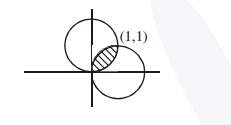Let $C_{1}$ be the curve obtained by the solution of differential equation $2 x y \frac{d y}{d x}=y^{2}-x^{2}, x>0$.
Let the curve $C_{2}$ be the solution of
$\frac{2 x y}{x^{2}-y^{2}}=\frac{d y}{d x}$. If both the curves pass through
$(1,1)$, then the area enclosed by the curves $C_{1}$ and $C_{2}$ is equal to :
Correct Option: , 2
$\frac{\mathrm{dy}}{\mathrm{dx}}=\frac{\mathrm{y}^{2}-\mathrm{x}^{2}}{2 \mathrm{xy}}, \quad \mathrm{x} \in(0, \infty)$
put $y=v x$
$x \frac{d v}{d x}+v=\frac{v^{2}-1}{2 v}$
$\frac{2 v}{v^{2}+1} d v=-\frac{d x}{x}$
Integrate,
$\ln \left(\mathrm{v}^{2}+1\right)=-\ln \mathrm{x}+\mathrm{C}$
$\ln \left(\frac{\mathrm{y}^{2}}{\mathrm{x}^{2}}+1\right)=-\ln \mathrm{x}+\mathrm{C}$
put $x=1, y=1, C=\ln 2$
$\ln \left(\frac{\mathrm{y}^{2}}{\mathrm{x}^{2}}+1\right)=-\ln \mathrm{x}+\ln 2$
$\Rightarrow x^{2}+y^{2}-2 x=0 \quad\left(\right.$ Curve $\left.C_{1}\right)$
Similarly,
$\frac{d y}{d x}=\frac{2 x y}{x^{2}-y^{2}}$
Put $y=v X$
$x^{2}+y^{2}-2 y=0$

required area $=2 \int_{0}^{1}\left(\sqrt{2 x-x^{2}}-x\right) d x=\frac{\pi}{2}-1$
Click here to get exam-ready with eSaral
For making your preparation journey smoother of JEE, NEET and Class 8 to 10, grab our app now.
